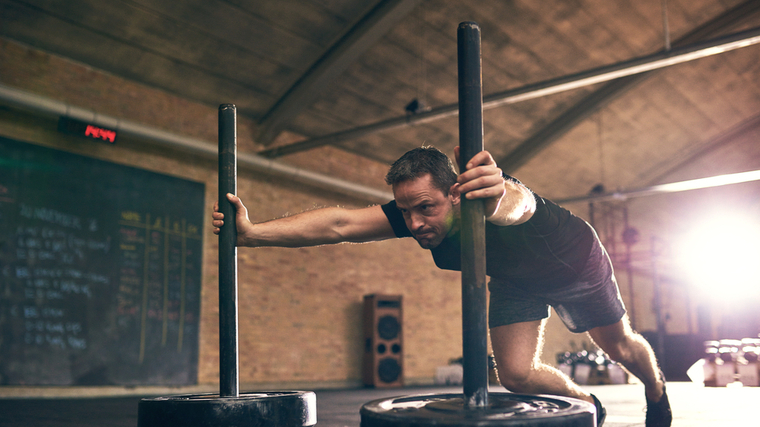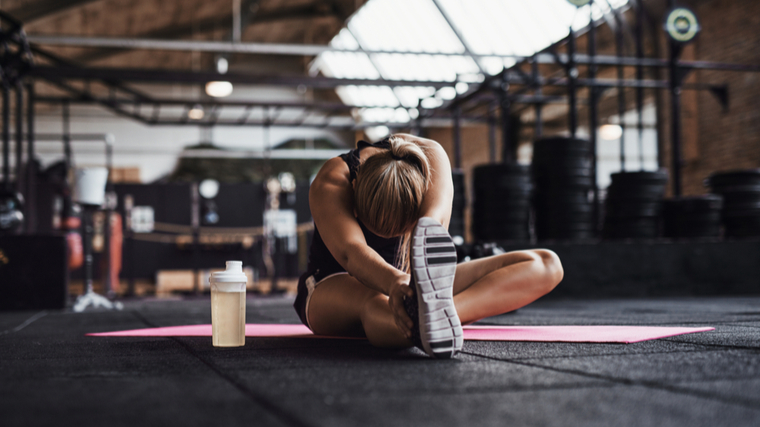Active recovery days are the golden ticket for many top athletes. Healing from intense workouts is not just about ice baths and deep tissue massages, or taking care of your nutrition or sleep habits. But it’s also about how you move when you’re not in the gym.
If your muscles are sore after a heavy lifting session, it’s tempting to stay on the couch until your next gym session. But getting up and moving around a little — or a lot — can help you get back in the game a lot faster. You’ll bounce back faster and train your body and mind to be able to handle heavier loads when you’re back on the platform.

This article will take you through everything you need to know about what exercises you should do on your active recovery days, why these days are so important, and how often you should take them.
What Is Active Recovery
Active recovery days are pretty much what they sound like — you’re recovering from your intense workouts by using activity. Instead of taking complete rest, you’re strategically moving your body in low-impact but highly effective ways.
Active recovery days should be just as much a part of your program as your regular lifting days. By making them a structured part of your routine, you’ll be keeping your body as safe as you can from overtraining. You’re also setting yourself up for success by prioritizing mobility, flexibility, and short bouts of steady state cardio.
Benefits of Active Recovery
Active recovery days are good for your body, mind, and your PRs. From the cellular level to improving your mental stamina, bouts of active rest can help you become the most sustainable athlete you can be. Here are some of the benefits of moving around a bit more on your non-workout days:
- Improved Muscle Recovery: Performing low intensity exercises on active rest days will improve blood flow throughout your body and help flush muscular waste products like metabolites or lactic acid, which build up when you’re training intensely. This gives your body a chance to reset your equilibrium.
- Provides a Mental Break: Keeping intensity low will serve as a reminder that taking it easy once in a while isn’t a cop out — it’s necessary. In other words, you can temper your training anxiety somewhat by training on your “off” days.
- Helps Prevent Injury: Active recovery days are great for increasing blood circulation, and you can do some smart prehab exercises or stretching as well as ways of shoring yourself up against future injuries.
Active Recovery Workout Examples
A good active recovery day needs just as much structure as a good lifting day. If the core of your active recovery day will be low-impact total body conditioning, you’ll want to thoroughly warm up first to avoid injury, as getting hurt on recovery day would be counterproductive.

You’ll want some structure even if you’re “only” doing steady state cardio or stretching. For example, that yoga class you’re going to for your active recovery day — a great idea — has a beginning, middle, and end. You don’t just dive into the most complicated poses. Similarly, if you’re going for a slow swim, bike, or jog, move through some dynamic warmups first just to make sure your body is ready.
Steady-State Cardio
The primary focus here is to increase body temperature and increase systemic blood flow. Often, choosing a modality such as air biking, swimming, and/or rowing is a great low impact and intensity piece. When choosing your intensity, try to train between 60-80% of your max heart rate for 10-30 minutes.
Dynamic Warm-Up
Deploying these moves on active recovery days can help you recover harder and lift heavier as well. If you’ve got a dynamic warmup routine of your own, you might want to adapt that for your recovery days. On the other hand, if you’re new to dynamic warmups, try these moves for your active recovery day.
- Cat Cows:3 x 10 breaths
- Bird Dogs: 3 x 10 per side
- Three-Way Ankle Mobilization: 3 x 10 rounds
- Walking Spiderman with Hip Lift and Overhead Reach: 3 x 8 per side
- Inchworm with Hip Opener : 3 x 8
- 90/90 Flow: 3 x 45 seconds back and forth
- Mini Band Wall Slide: 3 x 15
Mobility and Corrective Circuits
To improve your mobility on active rest days, perform four total rounds of the following after your dynamic warm-up. Focus on precise repetitions, controlled contractions, and constant movement from station to station.
- X-Band Walks: 20 steps per leg
- Banded Shoulder Prehab Complex: 10 repetitions per movement
- Face Pull with External Rotation
- Straight Arm Pulldown
- Bear Hug
- Standing Snow Angels
- Banded Overhead Squat
- Archer Row
- Cossack Squat: 5 repetitions per leg
Repeat this circuit two or three times. Rest for two to three minutes between circuits.
[RELATED: Best Mobility Exercises]
Total Body Conditioning
For this active recovery conditioning workout, you’ll be Integrating timed metcons, also known as such as EMOMs (every minute on the minute). You’ll perform the indicated exercises at the top of every minute. The more efficiently you do your reps, the more rest you’ll have before the next round begins.
Once you’ve prepped your body with the above active recovery components, perform this 15 minute EMOM (5 total rounds of three different exercises).
- Sled Push/Pull: 30 seconds at moderate intensity
- Turkish Get Up: 30 seconds at moderate intensity
- Handstand Hold: 30 seconds (modify as full plank or with feet on wall as needed)
Static Stretching And Meditation For Active Recovery
Once you’re ready to cool down, you need to do so with your body and your mind. Static stretching works to increase range of motion and provide a means of relaxation. It’s best performed after your muscles have warmed-up through their fullest ranges of motion.
Try these static stretches to cool down and limber up on your active recovery day.
- Deep Squat Hold: 30 seconds
- Runner’s Calf Stretch: 30 seconds per side
- Thread the Needle: 30 seconds per side
- Lizard Pose: 30 seconds per side
- Puppy Pose: 30 seconds per side
- Scorpion Stretch: 30 seconds
- Child’s Pose: 60-90 seconds
Breathing into your stretches will help to relieve stress and augment flexibility. It can become meditative in nature. On every inhale, make your body longer. On every exhale, sink deeper into the stretch.
If you’re new to meditation, that connected breathing might be the most meditating you do for now. But if you’re ready to practice more, try sitting or lying down on your mat for ten deep breaths in and ten deep breaths out. Clearing your mind through meditation is a sure-fire way to improve your lifts, and getting started will help you zone in on the platform when it’s time to PR.
How Often Do You Need Active Recovery?
How often you need a recovery day depends on your training intensity and the quality of your recovery. If you’re training reasonably hard and you’re sleeping and eating enough, your body will likely respond well to a weekly active recovery day. If your sleep and nutrition are on point, you can probably kick up the activity level on these days a bit if desired.
However, if you’re training very hard and possibly not recovering well otherwise, you might want to pull back from more intense active recovery. Instead, you might opt for sticking with yoga or long strolls (and possibly cutting back on the intensity of your lifting until you can balance out your healing).
Got a three or four day per week program? Start with one active recovery day and see if your body responds well enough to add a second each week. If you’re training five or six days a week, keep it to one active recovery training session.
Difference Between Active and Passive Recovery
The old adage “time heals all wounds” holds up when it comes to fitness as well, for the most part. If active recovery involves performing some low-level, low-intensity exercise to help you bounce back from your hard workouts, passive recovery simply refers to taking dedicated rest and letting your sleep, nutrition, and other factors take the wheel.
3 Ways To Approach Active Recovery
Active recovery “workouts” aren’t a strict requirement if you hit the gym on a regular basis. Like anything, some people will benefit from them more than others. You may find that too many active recovery days actually bog you down or make you more tired than you’d otherwise be. Here are three ways to implement them and test the waters:
- Plan an active recovery day once per week, ideally on the weekends if possible, so you can take things slow and enjoy a leisure activity like walking, hiking, or playing with a pet.
- If you follow a periodized training plan, consider implementing active recovery days after a phase of especially hard training with lots of volume.
- You can enlist the aid of a qualified strength coach or personal trainer to help you decide when the best time to implement active recovery is based on your unique needs.
Wrapping Up
You can take your recovery to the next level by employing all of these components into your weekly training sessions. At first, it may seem counterintuitive to move slower and lift lighter to improve your training. But over time, you’ll see that active recovery days can help prevent aches or overtraining, kick-start stalled progress, set you on the path to future gains in the gym.
Frequently Asked Questions
If “active recovery” feels like an oxymoron, don’t worry. Lots of athletes have trepidation about the prospect of getting to work on their days off. Let’s address some common questions about active recovery to put those worries to bed.
Is Active Recovery safe?
Active recovery, when done properly, is about facilitating a rest for your body and mind. Yes, you’ll be giving yourself some light cardio and mobility work to encourage your joints to stay limber. But even your full body conditioning — should you choose to do it — shouldn’t be all that high intensity.
Active recovery can help make your workouts potentially safer. Since you’ll be paying more attention to corrective exercises, you’ll be training your body and brain to be stricter about form, warm-ups, and mobility work. That’s a pretty good formula for creating a more resilient athlete.
Are Active Recovery days good for beginners?
Active recovery days can be great for beginners. You’ll be moving your body and giving yourself something to put in your fitness journal without overtaxing your body. It also helps you set good habits for later, when you are training more intensely.
That said, if you’re a beginner, you might want to avoid the conditioning component of active recovery days. It may be counterproductive if your active recovery day starts to feel exactly as active and challenging as your regular training days. Stick to mobility work and steady state cardio until you’ve built up more work capacity.
Are Active Recovery days useful for hypertrophy?
“If I’m not lifting heavy,” you ask, “then what’s the point? How the heck will I build muscle?” Muscle growth is typically associated with throwing weights around the gym, and it is true that active rest days aren’t about that.
But active recovery work can contribute to your muscle building goals. You’ll be focusing on corrective and mobility exercises, which can help your muscles prepare themselves to lift heavy next time you’re on the platform. And the more well-prepared they are, the better you can lift — and the better your muscles can grow. Similarly, you’ll be helping your body shake off soreness and get back to training a little sooner.
Featured Image: Flamingo Images / Shutterstock